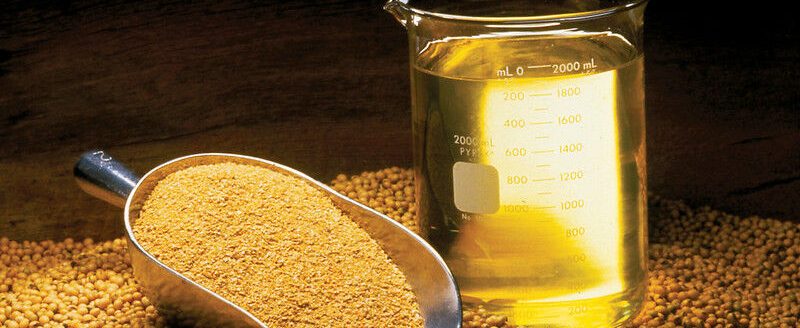To make better bacon, feed a better soybean. Bryon Wiegand, University of Missouri food scientist, studies the use of Missouri’s high-oleic soybean oil in livestock rations.
In a report at Soy Day, Wiegand joined MU faculty telling farmers how their soybean checkoff dollars support research. They spoke at the Bay Farm Research Facility east of Columbia.
MU plant breeders developed soybean varieties high in desirable high-oleic oil, a monounsaturated fat used in healthy diets.
“Bacon becomes a favorite garnish on everything,” Wiegand said. Bacon isn’t an unsaturated fat. His research shows high-oleic traits from the soybean transfer to animals.
High-oleic oil helps heart-healthy characteristics and adds storage life to food.
The pork industry stores tons of pork sides to make bacon, Wiegand said.
Introducing “new soybean uses” talks, Tony Stafford of the Missouri Soybean Merchandising Council said, “Farmers took a serious hit on soybean prices in the last 90 days.” Markets show a $2 per bushel drop in prices.
“With fewer exports, we must find new uses,” Stafford said. Both pork and soybean exports were hit by retaliatory tariffs from China. Chinese use both soy and pork in their diets, making them big buyers.
Using high-oleic soybean oil and meal isn’t new for Wiegand. He started livestock ration studies on lambs. Like cattle, sheep have rumens that break down feed into usable nutrients.
But rumens alter oleic carbon chains and desirable traits don’t easily pass to animal meat or fat.
Pigs, broilers and laying hens are non-rumen animals. “Pigs are what they eat,” Wiegand said. “The oleic nonsaturated fat passes through to animals.”
His research continues. “Broiler chicks have been fed high-oleic soybean diets, but that data isn’t analyzed,” he said.
Next up is a laying hen study. This isn’t to improve hen flesh for chicken soup but to improve egg yolks. “Already you can buy eggs with high omega-3 fatty acid,” Wiegand said. “We aim to add high-oleic content.”
Another high-oleic soybean study continues at the MU South Farm, where 30 steers are on oleic feed.
Soy Day, sponsored by the Missouri Soybean Merchandising Council, featured other researchers from the nearby Bradford Farm, part of the MU College of Agriculture, Food and Natural Resources. A big part of merchandising council dollars goes for research helping farmers.
MU researcher Andrew Scaboo leads a team of plant breeders making new soybean varieties.
Kevin Bradley, MU weed scientist, told of his studies to alleviate off-site damage from herbicides.
John Lory, MU Extension soil scientist, led talks on MU certified strip trials on farms across the state.
High-oleic soybean varieties were first developed by MU plant breeders. They used non-transgenic methods. Non-GMO crops open European Union markets.
MU holds the patent with USDA on the high-oleic oil soybean. Missouri Soybean Merchandising Council owns exclusive licensing of varieties from its research dollars. Dollar returns come to Missouri farmers.
Soybean is top cash crop in Missouri.
Breeding high-oleic soybean came from MU plant geneticist Grover Shannon and USDA Agricultural Research Service scientist Kristin Bilyeu at MU.
For lunch at Soy Day, food was deep-fried in high-oleic oil.
Earlier, the merchandising council estimated 18 million soybean acres are needed to meet U.S. demand.


